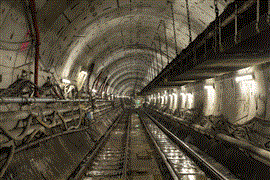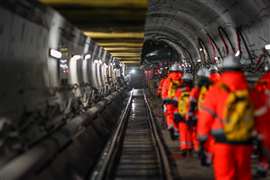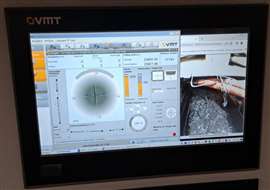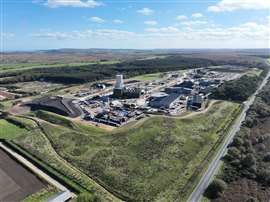How Strabag unintentionally broke a tunnelling world record
12 February 2024
 Inside the Woodsmith mine tunnel (Image: www.johnzammit.co.uk)
Inside the Woodsmith mine tunnel (Image: www.johnzammit.co.uk)
Deep underground and unbeknown to those enjoying the tranquility of England’s North York Moors National Park above, a tunnel boring machine (TBM) is slowly but steadily munching its way through hard rock.
The Herrenknecht TBM and the team in charge of it – main contractor Strabag working for client, mining company Anglo American – have already broken the world record for the longest single TBM drive in the world, a feat they achieved when the 4.9m-diameter tunnel reached a length of 25.8km late last year.
Now at over 27km, they still have another 10km to go, which will put the record safely ahead of any other challenger.
What makes it more impressive in some ways is the fact that when the project team started out on the tunnel, nobody knew they would be breaking a record at all.
 Workers inside the Woodsmith mine tunnel (Image courtesy of Anglo American)
Workers inside the Woodsmith mine tunnel (Image courtesy of Anglo American)
Anglo American won approval to mine the world’s largest known deposit of polyhalite, used as a fertiliser, from under heavily protected moorland, so long as the mine near Whitby was connected to its processing and distribution facility on Teesside underground. Early concepts for the project involved transporting the polyhalite through a shallow subterranean pipeline, dissolved in brine.
But the mining company eventually opted for what it claims is the more environmentally friendly option of a tunnel that runs up to 360m deep below the national park. Originally, the plan was to use three TBMs, one launching at either end of the tunnel and one starting at an intermediate shaft.
The first TBM, dubbed Stella-Rose by local primary school children, launched from the surface on Teesside in 2019. The two others were set to launch later from shafts reaching 380m below ground.
But progress with the first TBM proved so good that later that year, Anglo American made an agreement with Strabag to reduce to two tunnel drives. The longer of those two would have been a record-breaker in itself but the team still wasn’t initially aware of this. And even further down the line, the decision was made to stick with just one TBM, making for an even bigger record.
Good ground conditions and a strong team
 A navigation screen for the Herrenknecht TBM used for the record-breaking tunnel drive (Image courtesy of Anglo American)
A navigation screen for the Herrenknecht TBM used for the record-breaking tunnel drive (Image courtesy of Anglo American)
Explaining the decision, Craig Sewell, project director for Strabag, says, “The outputs of the TBM exceeded all of our expectations and there were a number of factors that contributed to that. One was the good ground conditions, as well as the quality of the equipment from the TBM manufacturer, and the fact that we have a large team of highly experienced people using this equipment and making it happen.”
Despite the scale of the project, Sewell says that it hasn’t proved to be as complex as other long tunnelling projects thanks to the ground conditions.
“Initially, from the launch ramp, there’s some variable conditions to go through clays and glacial tills but we fairly quickly get into Redcar mudstone which is a dry, steady-state rock and the rest of our TBM advance remains within that band of material,” Sewell says.
“So you get a fairly consistent advance rate and you can forecast the wear on the discs and other parts of the equipment fairly well. We do go through faults but prior to us starting the project we had a lot of good data on the fault zones and what we have gone through has been aligned to that data.”
In spring this year, the project comes to an extended technical stop where there will be some cutter head refurbishment and a ventilation shaft at Lady Cross Plantation within the national park is connected to the tunnel.
After that, Sewell says, the team will return to steady state mining for the whole of 2025 and into 2026, the year in which the tunnelling works are expected to complete.
New challenges
 Mark Pooleman (Image courtesy of Anglo American)
Mark Pooleman (Image courtesy of Anglo American)
Changing the number of TBMs involved in the Woodsmith tunnel hasn’t been without its challenges though, as Mark Pooleman, Anglo American’s area manager on the tunnel, points out.
“When we launched this first TBM, everything was designed to do a 12.5km tunnel drive. From the conveyor belt that exports the mineral, to the communications, the rescue procedures – when we made these fundamental decisions to revise the delivery strategy from three TBMs, to two TBMs, and now to one TBM, it’s a management of change procedure that isn’t just minor things,” he says.
“It’s a one-team approach and credit to all the engineers on both sides who worked out how these things are going to work and how we can have a 27km-long conveyor belt that gets longer every week.”
Sewell adds, “The tunnel length comes with unique challenges. Right now, we have 27km worth of infrastructure – the grout lines, the conveyor belt, the rails. So there is a huge amount of work that goes into the maintenance and into the scheduling of maintenance periods versus operational time on the TBM. There is a lot of learning for the entire team on how we can maximise our efficiency with all of those challenges.
“We are now pumping grout for 15km from Lockwood Beck [a reservoir between Guisborough and Whitby] to the TBM, which I think is totally unprecedented. All of these challenges require a huge team effort from Anglo American, to ourselves, through to key suppliers to make sure we keep on top of these critical issues.”
Because of the logistical challenges involved in a single tunnel drive and the extra people required to facilitate solutions to them, Pooleman says that there “pluses and minuses” to using one TBM instead of three and that there hasn’t been “a huge magnitude of change” in terms of cost. Anglo American is reported to have spent £2 billion (US$2.5 billion) developing the Woodsmith project so far, while the total development cost could be up to £7 billion (US$9 billion).
Breaking the record
 The Woodsmith mine site (Image courtesy of Anglo American)
The Woodsmith mine site (Image courtesy of Anglo American)
There have been other rewards though, not least a sense of achievement once the team had realised they had broken a world record.
“I am hugely proud to be part of the project overall. I think it’s an incredible asset for the region and for the UK. And to set a world record on the tunnel is brilliant,” says Pooleman.
Sewell is pleased too. “It’s a nice milestone to achieve and for the team to celebrate. There’s a lot more on the project that we can be proud of and a lot more that it brings to the region that we are also extremely proud of.”
But he is also keen to remain focused on the task at hand. “We can’t let ourselves run away with becoming world record holders. We’ve still got another 10km to go, so that is our focus. It’s still the length of any normal tunnelling project. The real celebration will be at 36.7km,” he adds.
It’s at that point too that Guinness World Records would verify the achievement – for now there is little point given that the project team continues to break the record every day, as the TBM advances further.
Pooleman is also at pains highlight Mapei’s role in supplying the grout system, as well as praising TBM manufacturer Herrenknecht. “They supplied the machine and they have given incredible support to us considering that we haven’t gone and bought two more machines from them,” he says.
Andreas Leppert, senior project manager traffic tunnelling, at Herrenknecht adds, “This world record TBM drive is something that we are definitely proud of. We congratulate Strabag and Anglo American on this impressive achievement at the Woodsmith project. With Stella-Rose, the miners have set a new milestone in mechanized tunnelling.”
Pooleman concludes, “We see this as being a real innovation to the mining industry to use a tunnel such as this to export our mineral. It means that we never have to put the product on a train or into a truck, so it reduces the carbon footprint for mining and exporting this product. The mine itself is tiny compared to what it would otherwise be so it’s very low impact. This tunnel is an ultramodern asset for the project that we see as a gamechanger for the mining industry overall.”
STAY CONNECTED



Receive the information you need when you need it through our world-leading magazines, newsletters and daily briefings.
CONNECT WITH THE TEAM








